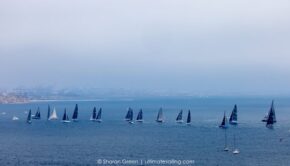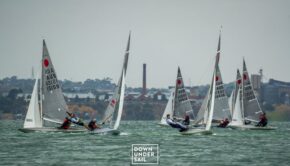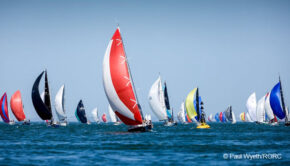Challenges in maintaining fairness
Published on September 15th, 2022
by Craig Leweck, Scuttlebutt Sailing News
The 32nd edition of Maxi Yacht Rolex Cup included an outlier amongst its stately monohulls when it accepted the entry of Roberto Lacorte’s 60-foot Flying Nikka, the first ever flying maxi, based on AC75 technology, with flip-up T-foils to port and starboard and a single rudder with an adjustable elevator.
Held September 4-10, with courses along north-east Sardinia’s Maddalena Archipelago in Italy, Flying Nikka’s lead designer Mark Mills shared a video clip showcasing his foiling yacht flying past the fleet. It was pretty remarkable.
The regatta uses the IRC rating system, and as this was Flying Nikka’s first regatta, assigning a rating was to be a longshot. No rating system has any experience with this kind of boat, and as it is always best to group boats of similar characteristics, Flying Nikka raced alone in a class created just for her. Yes, racing alone.
She was given a conservative IRC TCC of 3.866, comfortably surpassing the previous record TCC – the ClubSwan 125 Skorpios’ 2.149. But IRC is a single digit rule, and does not have options for course type or wind range. While non-foiling boats tend to have sweet spots while racing, the variance in a foiling boat’s performance is significant.
Flying Nikka was readily foiling upwind when the conditions were right, but the team remains on a steep learning curve with maneuvers, light wind take-off speeds, and displacement mode sailing in the lighter winds.
“At the moment we do not have much data to review Flying Nikka’s relative performance following the Maxi Yacht Rolex Cup,” says Dr Jason Smithwick, Director of the RORC Rating Office. “She suffered some breakage and conditions weren’t ideal with largely windward-leeward coastal races that involved much short tacking up Bomb Alley.
“Her initial rating we calculated on the basis she would mostly go out in fully foiling conditions, but watching her sailing we have seen there were regular foiling transition points. On that basis using the VPP data in the transition range, and updating our algorithm for full foilers, we have calculated a new rating that we will issue to the team once they get the boat out on the water again.”
Okay, but without another foiler to race against, and a single number system that would seem unlikely to fairly rate her in all conditions and courses, what are we doing? Can this sport be fair when such variety is permitted?
It will be interesting to see the reaction if the ClubSwan 125 must race in the same division as Flying Nikka, as people that pay the high price for a boat twice the size may not have envisioned this kind of playing field.









 We’ll keep your information safe.
We’ll keep your information safe.